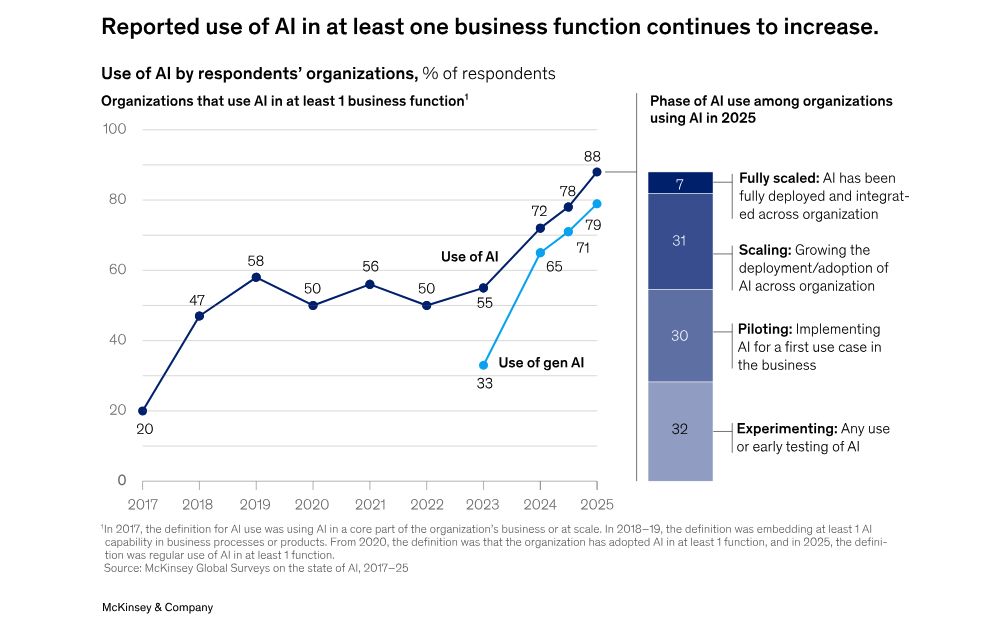
Technology is crucial for business success. But can it replace human expertise? Read on to learn how you can balance the two.
With the increasingly convenient availability of AI business solutions, most brands are starting to incorporate these tools into their workflows.
Research from McKinsey shows that, as of 2025, 88% of companies use AI in at least one function. And when it comes to industry leaders, DemandSage found that 99% of Fortune 500 companies use AI, most commonly for recruitment and management processes.
If you add to this the tremendous popularity of generative AI (with 79% of organizations incorporating it into their workflows), it comes as no surprise that one of the biggest business challenges of the moment includes balancing technology and human expertise.
Yes, AI (and technology, in general) can be exceptionally helpful in achieving impressive business results and speeding up brand growth. But it’s not a choice that comes without a price. In fact, modern consumers seek and demand a human touch, showing the importance of blending empathy and innovation.
So, if you want to get the most out of tech but don’t want to lose your brand’s humanity, here’s how to balance technology and human expertise, along with some examples of smart strategies you can adopt. Let’s get started.
Source: mckinsey.com
Technology vs. Humanity: How They Influence Business Operations
Let’s face it. Choosing between innovative technology and human expertise to drive business success can be a tough call to make. After all, both offer very attractive benefits. Yet opting for one over the other can also come with drawbacks.
Ultimately, the ideal balance for your brand will depend on internal factors. These include the structure of your company, your target audience, and the niche in which you operate.
Nevertheless, you don’t necessarily have to give up on either. Instead, focus on understanding how innovative solutions vs. humanity influence business operations and customer satisfaction.
The Productivity Question
If you approach the debate exclusively from the perspective of improving internal business operations, the answer is simple. Technology reigns supreme.
For instance, research from the NN Group suggests that generative AI solutions boost business productivity by as much as 66% in specific settings. Moreover, artificial intelligence does splendidly at automating tasks, minimizing human error, and streamlining workflows.
If your primary goal includes making your employees’ work easier (or just supporting them with an AI system to ensure maximum results), then AI can be a great choice.
The Leadership Perspective
Now, even though innovation can help advance your business, successfully implementing it in your business operations necessitates that you consider its impact on team morale.
A few years back, the idea of AI in the workplace instantly awakened fear. In 2025, however, things are quite different. Many employees use AI for more than 30% of their assignments. An even larger number expects to incorporate such solutions into their workflows over the next one to five years.
But here’s the thing. The general consensus is that leadership isn’t doing enough to aid employees’ use of AI. According to a recent report, 48% of workers wish their companies could provide formal AI training. 45% wish for better integration. And 41% seek better access to generative AI tools.
So, the question of hitting a balance doesn’t come down to a “yes” or “no” choice. Instead, it’s all about empathy, empowering workers, and supporting them in adopting innovative solutions to optimize their workflows.
What the Modern Customer Says
Finally, when it comes to balancing technology and humanity, know that it doesn’t just influence your organization’s internal operations. Instead, how you use tech has a hugely significant impact on customer experience.
For example, contemporary consumers are more willing to interact with self-service and AI-powered support resources than before. But they still primarily trust humans.
According to Edelman’s 2025 Trust Barometer report, 74% of consumers trust scientists to tell the truth about innovations and new tech. But the same percentage of people will also trust their peers. Furthermore, company technical experts rank high on the list of credible sources of information, showing that a face and a name can go a long way in creating a sense of trust and safety.
What these findings also suggest is that, despite innovation being a tremendous aid in driving business results, it cannot exist in a limbo without a touch of humanity.
How to Balance Technology and Human Expertise
Ultimately, balancing technology with human expertise will look different for every business.
There’s no such thing as an ideal solution. Instead, there’s only tailoring and adjustment paired with a consistent desire to move forward in optimizing internal operations, elevating employee productivity (without sacrificing happiness), and boosting customer satisfaction.
With that in mind, here are a few effective tactics for embracing technology while maintaining your brand’s humanity — inside and out.
Prioritize Human Talent, But Support Employees with Good Tech
Great employees are crucial for driving business success.
Research suggests that talent is one of the most important factors for building a strong brand. And the right hires can even redefine what a single person can do.
According to research from the Harvard Business Review, high-performing employees can be up to 400% more productive (in general roles) than their peers. And when it comes to highly complex occupations, they can be as much as eight times more effective than their colleagues.
But here’s the deal. In an unstable global economy, most businesses are trying to be rational with their spending. And, in many cases, that means replacing talent with tech in an attempt to cut costs.
However, if you’re looking to boost business growth and success, the way to go isn’t to replace humans with AI. Instead, blend innovation and empathy to get the most out of both.
For example, something as simple as prioritizing human talent but being flexible with your work model can open up many doors. Hiring services like Somewhere, for instance, can help you attract and hire elite global talent while saving up to 70% by hiring staff from South Africa, the Philippines, and Latin America.
Alternatively, if you rely on an in-house team, explore opportunities to support them with superior technology. If two-in-five employees want their organizations to provide better access to generative AI, chances are, your team could also benefit from upgrading your tools.
A good rule of thumb for doing this is to look at your team’s workflow and identify gaps and opportunities for improvement. Then, choose the best tech to fill those gaps, rather than trying to change processes that are already working great and don’t necessarily require instant upgrades.
Combine Advanced Tools and Technology with Human Expertise
Another excellent strategy for balancing technology and human expertise is not to allow one to exclude the other.
Yes, tech can be helpful in elevating convenience, speed, and productivity. But it’s nowhere near as effective at resolving issues as your team of experts.
So, if you want to blend empathy and innovation in your business — particularly when dealing with customers — explore opportunities to combine new tools and formats with old-fashioned human expertise.
For example, this can look really simple. Instead of forcing your audience to read a manual, why not produce instructional videos starring your in-house team to help the onboarding process? It’s not a complicated strategy. Yet the customer experience benefits are tremendous, especially if you consider that watching videos is people’s most preferred way to collect product information pre- and post-purchase. For example, check out how medical alert systems brand Bay Alarm Medical did it:
Source: bayalarmmedical.com
Or how about this? If you use AI chatbots to provide customer support, a super-effective method to maintain a much-needed dose of humanity is to allow escalation to a human agent.
Alternatively, use your target audience’s preferred digital channels to provide them with the support they need. Brands like Glossier do this on TikTok, where they answer customer questions and help buyers through the sales cycle to ensure they receive the best CX possible.
Source: tiktok.com
Use AI for Drafts, But Enrich with Expert Knowledge
Finally, if you’re exploring ways to balance technology and human expertise, don’t forget that one of the most widespread innovative solutions out there includes generative AI.
Now, such tools can be a marvelous way to streamline your brand’s marketing tactics and even boost brand and product awareness — especially among top-of-the-funnel consumers. But they have one big downside. They’re not always effective at allowing your brand’s credibility and competence to shine through.
So, instead of fully relying on gen AI to handle your content marketing, explore the opportunity of using it to create first drafts. Then, enrich those outlines with expert knowledge that will allow your brand’s competence and trustworthiness to shine through, allowing you to stand out from your competitors.
Or, even better, use innovative technology for its attractiveness and make it a big part of your marketing campaigns. Heinz, for instance, created an exceptional “This is what ketchup looks like” campaign, which synthesizes the brand’s iconic visual identity with the unexpected creativity of artificial intelligence to show that Heinz remains the brand most commonly associated with this condiment.
Source: youtube.com
Final Thoughts
Finding the balance between technology and humanity can be challenging — especially when you’re trying to optimize business processes for the sake of profitability.
However, the truth is that humanity, empathy, and expertise are irreplaceable, even in the digital world. So, ensure you make room for them in your business strategy. And don’t hesitate to use them to guide (and improve) your adoption of innovative solutions.
Yes, it may make the process a bit lengthier. But in the end, it’ll be more than worth it, regardless of whether you look at it from your employees’ or customers’ point of view.
Was this news helpful?









 Yes, great stuff!
Yes, great stuff! I’m not sure
I’m not sure No, doesn’t relate
No, doesn’t relate



